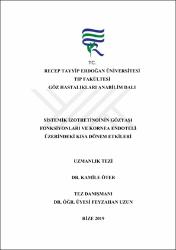Sistemik izotretinoinin gözyaşı fonksiyonları ve kornea endoteli üzerine olan kısa dönem etkileri
Abstract
Gereç ve Yöntem: Çalışma Recep Tayyip Erdoğan Üniversitesi Tıp Fakültesi Göz Hastalıkları Anabilim Dalı'nda yapıldı. Akne vulgaris tanısı ile sistemik izotretinoin (0.5-1.0 mg/kg/gün) başlanan 38 hastanın (23 kadın, 15 erkek) 38 gözü çalışmaya dahil edildi. Tüm hastalara tedavi öncesinde ve tedavinin 1. ve 3. ayında detaylı oftalmolojik muayene yapıldı. Hastaların subjektif yakınmaları oküler yüzey hastalık indeksi (OYHİ) ile sorgulandı. Non-invaziv gözyaşı kırılma zamanı (NIGKZ), Schirmer I testi ve meibografi ölçümleri ile gözyaşı fonksiyonları; temassız speküler mikroskopi ölçümü ile de kornea endoteli değerlendirildi. Bulgular: Hastaların yaş ortalaması 19.29±2.83 yıldı. Hastaların OYHİ skorları tedavi öncesi 12.18±12.75, tedavinin 1. ayında 13.66±12.40, 3. ayında 26.98±22.09 olarak tespit edildi ve tedavi öncesi ile karşılaştırıldığında 3. ay ölçümlerinde istatistiksel olarak anlamlı artış görüldü (p<0.001). NIGKZ, tedavi öncesi 13.03±5.29 sn iken, tedavinin 1.ayında 9.60±6.18 sn, 3. ayında 10.95±5.20 sn olarak saptandı. Tedavinin 1. ayında NIGKZ'de görülen azalma istatistiksel olarak anlamlıydı (p<0.05). Meibomian kayıp yüzdesi tedavi öncesi 10.59±6.42, 1. ayda 12.71±7.67 ve 3. ayda 15.58±8.3 olarak tespit edildi. 3. ay değerlerinde 1. ay ve tedavi öncesine göre anlamlı artış mevcuttu (p<0.001). 1. ay sonuçları da tedavi öncesine göre anlamlı olarak artmıştı (p<0.05). Ortalama Schirmer testi değerleri sırasıyla 22.37±8.52 mm, 24.56±7.99 mm, 22.97±10.74 mm olarak ölçüldü. Değerler arasında istatistiksel olarak anlamlı fark bulunmadı. Hastaların speküler mikroskopi ölçümleri ile kornea endotel tabakası ve santral kornea kalınlığı değerlendirildi. Santral kornea kalınlığı (SKK) tedavi öncesi, 1. ay ve 3. ay değerleri sırasıyla 536.53±38.38 µm, 531.73±33.63 µm, 532.77±37.14 µm olarak ölçüldü. Tedavi öncesi ve tedavi süresince ölçümler arasında anlamlı fark saptanmadı. Endotel hücre sayısı (CD) sırasıyla 2768.79±244.50 hücre/mm2, 2580.37±224.44 hücre/mm2, 2558.61±291.15 hücre/mm2 idi. Hücre alanının değişkenlik katsayısı (CV) sırasıyla 37.55±4.76, 43.29±6.96, 44.16±7.24 idi. Hekzagonal hücre oranı (6A) sırasıyla 47.81±8.18 (%), 40.65±9 (%), 39.89±9.63 (%) olarak ölçüldü. 3. ay ve 1. ay CD, CV, 6A ölçümlerinde tedavi öncesine göre anlamlı değişiklik izlendi (p<0.001). Ancak 3. ay ve 1. ay karşılaştırılmasında anlamlı fark bulunamadı. Ortalama hücre alanı (AVG) tedavi öncesinde 364.03±33.47 µm2 tedavinin 1. ayında 390.37±33.94 µm2, tedavinin 3. ayında 388.61±75.60 µm2 olarak ölçüldü. Tedavinin 1. ay ölçümlerinde tedavi öncesine göre anlamlı artış mevcuttu (p<0.001). Sonuç: Bu çalışmada; sistemik izotretinoinin gözyaşı stabilitesini bozduğu, meibomian bezinde atrofiye neden olduğu ve hastalarda semptomatik şikayetlere sebep olduğu belirlendi. Gözyaşı hacminde değişiklik gözlenmedi. Kornea speküler mikroskopi ile değerlendirildiğinde tedavinin 1. ayından itibaren endotel hücre sayısında azalma, hücre alanı değişkenlik katsayısında artma (polimegatizm), hekzagonal hücre sayısında azalmaya (polimorfizm) ve ortalama hücre alanında artma izlendi. Aim: The study aims to investigate the short term changes in tear function and corneal endothelium in patients using systemic isotretinoin. Materials and Methods: The study was conducted at Recep Tayyip Erdoğan University Faculty of Medicine Department of Ophthalmology. The study included 38 eyes of 38 patients (23 female and 15 male) who treated with systemic isotretinoin (0.5-1.0 mg/kg/day) after the diagnosis of acne vulgaris. All patients underwent a detailed ophthalmologic examination at baseline and at the 1st and 3rd month of treatment. The subjective complaints of the patients were examined by ocular surface disease index (OSDI). Tear functions were assessed by non-invasive tear break up time (NIBUT), Schirmer I test and meibography measurements and corneal endothelium was evaluated by non-contact specular microscopy. Results: The mean age of the patients was 19.29±2.83 years. OSDI values of patients were 12.18±12.75 at baseline, 13.66±12.40 at the 1st and 26.98±22.09 at the 3rd month of the treatment. A statistically significant increase was determined in the 3rd month measurements when compared to the pre-treatment values (p<0.001). Mean NIBUT was 13.03±5.29 sec. at the baseline, 9.60±6.18 sec. at the 1st month and 10.95±5.20 sec. at the 3rd month of the treatment. At the 1st month of the treatment, the decrease in NIBUT was statistically significant (p<0.05). The percentage of loss of Meibomian glands was 10.59±6.42 at the baseline, 12.71±7.67 at the 1st and 15.58±8.3 at the 3rd month. In the 3rd month, there was a significant increase compared to the 1st month and pre-treatment period (p<0.001). The results belonging to the 1st month also significantly increased compared to pre-treatment (p<0.05). The mean Schirmer test values were calculated as 22.37±8.52 mm, 24.56±7.99 mm and 22.97±10.74 mm, respectively. No statistically significant difference was found between the values. The corneal endothelial layer and central corneal thickness (CCT) were evaluated by specular microscopy. CCT was measured as 536.53±38.38 µm, 531.73±33.63 µm and 532.77±37.14 µm, respectively. No significant difference was observed between the measurements before and during the treatment. The endothelial cell count (CD) was 2768.79±244.50 cells/mm², 2580.37±224.44 cells/mm², 2558.61±291.15 cells/mm², respectively. The variability coefficient (CV) of the cell area was 37.55±4.76, 43.29±6.96, 44.16±7.24, respectively. The hexagonal cell ratio (6A) was measured as 47.81±8.18 (%), 40.65±9 (%), 39.89±9.63 (%), respectively. CD, CV, 6A measurements at the 1st and 3rd months showed a significant change compared to the pre-treatment (p<0.001). However, there was not any significant difference between the 3rd and the 1st month. The mean cell area (AVG) was calculated as 364.03±33.47 µm² before the treatment, 390.37±33.94 µm² in the 1st month of the treatment and 388.61±75.60 µm² in the 3rd month of the treatment. There was a significant increase at the 1st month of the treatment compared to the pre-treatment (p<0.001). Conclusion: In this study, it was determined that systemic isotretinoin disrupted tear stability, caused atrophy in the meibomian glands and led to symptomatic complaints in patients. Any changes in tear volume were not observed. When the cornea was evaluated with specular microscopy, a decrease in endothelial cell count, an increase in cell area variability coefficient (polymegathism), a decrease in hexagonal cell number (polymorphism) and an increase in average cell area was observed.


















